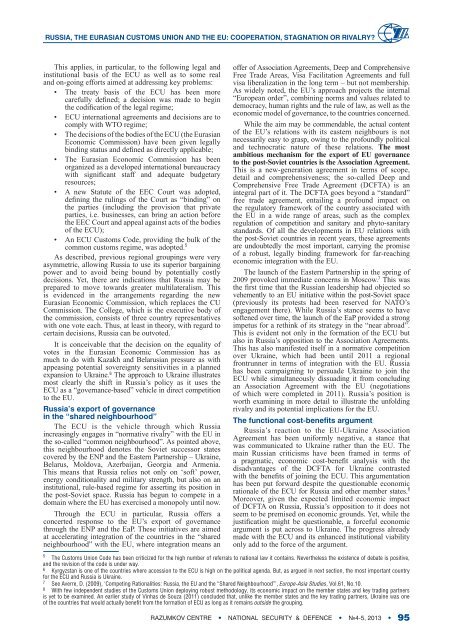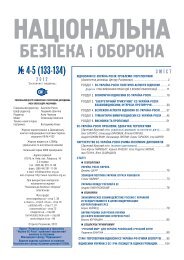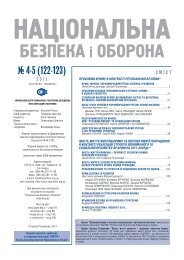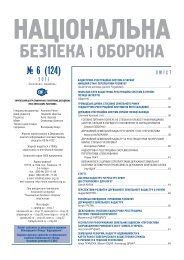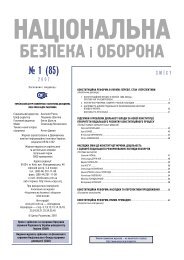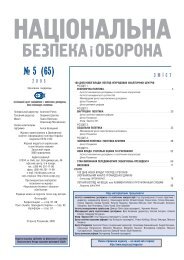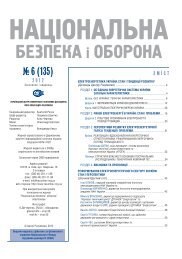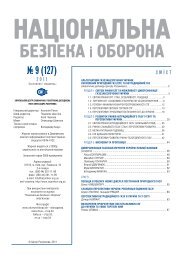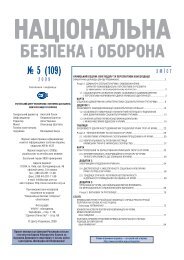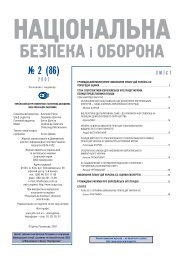RUSSIA THE EURASIAN CUSTOMS UNION AND THE EU COOPERATION STAGNATION OR RIVALRY?
RUSSIA, THE EURASIAN CUSTOMS UNION AND THE EU ...
RUSSIA, THE EURASIAN CUSTOMS UNION AND THE EU ...
- No tags were found...
Create successful ePaper yourself
Turn your PDF publications into a flip-book with our unique Google optimized e-Paper software.
<strong>RUSSIA</strong>, <strong>THE</strong> <strong><strong>EU</strong>RASIAN</strong> <strong>CUSTOMS</strong> <strong>UNION</strong> <strong>AND</strong> <strong>THE</strong> <strong>EU</strong>: <strong>COOPERATION</strong>, <strong>STAGNATION</strong> <strong>OR</strong> <strong>RIVALRY</strong>?<br />
This applies, in particular, to the following legal and<br />
institutional basis of the ECU as well as to some real<br />
and on-going efforts aimed at addressing key problems:<br />
• The treaty basis of the ECU has been more<br />
carefully defined; a decision was made to begin<br />
the codification of the legal regime;<br />
• ECU international agreements and decisions are to<br />
comply with WTO regime;<br />
• The decisions of the bodies of the ECU (the Eurasian<br />
Economic Commission) have been given legally<br />
binding status and defined as directly applicable;<br />
• The Eurasian Economic Commission has been<br />
organized as a developed international bureaucracy<br />
with significant staff and adequate budgetary<br />
resources;<br />
• A new Statute of the EEC Court was adopted,<br />
defining the rulings of the Court as “binding” on<br />
the parties (including the provision that private<br />
parties, i.e. businesses, can bring an action before<br />
the EEC Court and appeal against acts of the bodies<br />
of the ECU);<br />
• An ECU Customs Code, providing the bulk of the<br />
common customs regime, was adopted. 5<br />
As described, previous regional groupings were very<br />
asymmetric, allowing Russia to use its superior bargaining<br />
power and to avoid being bound by potentially costly<br />
decisions. Yet, there are indications that Russia may be<br />
prepared to move towards greater multilateralism. This<br />
is evidenced in the arrangements regarding the new<br />
Eurasian Economic Commission, which replaces the CU<br />
Commission. The College, which is the executive body of<br />
the commission, consists of three country representatives<br />
with one vote each. Thus, at least in theory, with regard to<br />
certain decisions, Russia can be outvoted.<br />
It is conceivable that the decision on the equality of<br />
votes in the Eurasian Economic Commission has as<br />
much to do with Kazakh and Belarusian pressure as with<br />
appeasing potential sovereignty sensitivities in a planned<br />
expansion to Ukraine. 6 The approach to Ukraine illustrates<br />
most clearly the shift in Russia’s policy as it uses the<br />
ECU as a “governance-based” vehicle in direct competition<br />
to the <strong>EU</strong>.<br />
Russia’s export of governance<br />
in the “shared neighbourhood”<br />
The ECU is the vehicle through which Russia<br />
increasingly engages in “normative rivalry” with the <strong>EU</strong> in<br />
the so-called “common neighbourhood”. As pointed above,<br />
this neighbourhood denotes the Soviet successor states<br />
covered by the ENP and the Eastern Partnership – Ukraine,<br />
Belarus, Moldova, Azerbaijan, Georgia and Armenia.<br />
This means that Russia relies not only on ‘soft’ power,<br />
energy conditionality and military strength, but also on an<br />
institutional, rule-based regime for asserting its position in<br />
the post-Soviet space. Russia has begun to compete in a<br />
domain where the <strong>EU</strong> has exercised a monopoly until now.<br />
Through the ECU in particular, Russia offers a<br />
concerted response to the <strong>EU</strong>’s export of governance<br />
through the ENP and the EaP. These initiatives are aimed<br />
at accelerating integration of the countries in the “shared<br />
neighbourhood” with the <strong>EU</strong>, where integration means an<br />
offer of Association Agreements, Deep and Comprehensive<br />
Free Trade Areas, Visa Facilitation Agreements and full<br />
visa liberalization in the long term – but not membership.<br />
As widely noted, the <strong>EU</strong>’s approach projects the internal<br />
“European order”, combining norms and values related to<br />
democracy, human rights and the rule of law, as well as the<br />
economic model of governance, to the countries concerned.<br />
While the aim may be commendable, the actual content<br />
of the <strong>EU</strong>’s relations with its eastern neighbours is not<br />
necessarily easy to grasp, owing to the profoundly political<br />
and technocratic nature of these relations. The most<br />
ambitious mechanism for the export of <strong>EU</strong> governance<br />
to the post-Soviet countries is the Association Agreement.<br />
This is a new-generation agreement in terms of scope,<br />
detail and comprehensiveness; the so-called Deep and<br />
Comprehensive Free Trade Agreement (DCFTA) is an<br />
integral part of it. The DCFTA goes beyond a “standard”<br />
free trade agreement, entailing a profound impact on<br />
the regulatory framework of the country associated with<br />
the <strong>EU</strong> in a wide range of areas, such as the complex<br />
regulation of competition and sanitary and phyto-sanitary<br />
standards. Of all the developments in <strong>EU</strong> relations with<br />
the post-Soviet countries in recent years, these agreements<br />
are undoubtedly the most important, carrying the promise<br />
of a robust, legally binding framework for far-reaching<br />
economic integration with the <strong>EU</strong>.<br />
The launch of the Eastern Partnership in the spring of<br />
2009 provoked immediate concerns in Moscow. 7 This was<br />
the first time that the Russian leadership had objected so<br />
vehemently to an <strong>EU</strong> initiative within the post-Soviet space<br />
(previously its protests had been reserved for NATO’s<br />
engagement there). While Russia’s stance seems to have<br />
softened over time, the launch of the EaP provided a strong<br />
impetus for a rethink of its strategy in the “near abroad”.<br />
This is evident not only in the formation of the ECU but<br />
also in Russia’s opposition to the Association Agreements.<br />
This has also manifested itself in a normative competition<br />
over Ukraine, which had been until 2011 a regional<br />
frontrunner in terms of integration with the <strong>EU</strong>. Russia<br />
has been campaigning to persuade Ukraine to join the<br />
ECU while simultaneously dissuading it from concluding<br />
an Association Agreement with the <strong>EU</strong> (negotiations<br />
of which were completed in 2011). Russia’s position is<br />
worth examining in more detail to illustrate the unfolding<br />
rivalry and its potential implications for the <strong>EU</strong>.<br />
The functional cost-benefits argument<br />
Russia’s reaction to the <strong>EU</strong>-Ukraine Association<br />
Agreement has been uniformly negative, a stance that<br />
was communicated to Ukraine rather than the <strong>EU</strong>. The<br />
main Russian criticisms have been framed in terms of<br />
a pragmatic, economic cost-benefit analysis with the<br />
disadvantages of the DCFTA for Ukraine contrasted<br />
with the benefits of joining the ECU. This argumentation<br />
has been put forward despite the questionable economic<br />
rationale of the ECU for Russia and other member states. 8<br />
Moreover, given the expected limited economic impact<br />
of DCFTA on Russia, Russia’s opposition to it does not<br />
seem to be premised on economic grounds. Yet, while the<br />
justification might be questionable, a forceful economic<br />
argument is put across to Ukraine. The progress already<br />
made with the ECU and its enhanced institutional viability<br />
only add to the force of the argument.<br />
5<br />
The Customs Union Code has been criticized for the high number of referrals to national law it contains. Nevertheless the existence of debate is positive,<br />
and the revision of the code is under way.<br />
6 Kyrgyzstan is one of the countries where accession to the ECU is high on the political agenda. But, as argued in next section, the most important country<br />
for the ECU and Russia is Ukraine.<br />
7 See Averre, D. (2009), ‘Competing Rationalities: Russia, the <strong>EU</strong> and the “Shared Neighbourhood”’, Europe-Asia Studies, Vol.61, No.10.<br />
8 With few independent studies of the Customs Union deploying robust methodology, its economic impact on the member states and key trading partners<br />
is yet to be examined. An earlier study of Vinhas de Souza (2011) concluded that, unlike the member states and the key trading partners, Ukraine was one<br />
of the countries that would actually benefit from the formation of ECU as long as it remains outside the grouping.<br />
RAZUMKOV CENTRE • NATIONAL SECURITY & DEFENCE • №4-5, 2013 • 95


